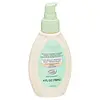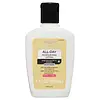What's inside
What's inside
 Key Ingredients
Key Ingredients

 Benefits
Benefits

 Concerns
Concerns

 Ingredients Side-by-side
Ingredients Side-by-side

Water
Skin ConditioningC12-15 Alkyl Benzoate
AntimicrobialCetearyl Alcohol
EmollientGlycerin
HumectantDimethicone
EmollientGlycine Soja Seed Extract
Skin ConditioningBis-Phenylpropyl Dimethicone
Arachidyl Alcohol
EmollientCetearyl Glucoside
EmulsifyingBenzyl Alcohol
PerfumingPanthenol
Skin ConditioningEthylene/Acrylic Acid Copolymer
Emulsion StabilisingBehenyl Alcohol
EmollientSteareth-2
EmulsifyingParfum
MaskingSteareth-21
CleansingPolymethyl Methacrylate
Polyacrylamide
Arachidyl Glucoside
EmulsifyingDisodium EDTA
C13-14 Isoparaffin
EmollientLaureth-7
EmulsifyingSilica
AbrasiveChlorphenesin
AntimicrobialBHT
AntioxidantTitanium Dioxide
Cosmetic ColorantMica
Cosmetic ColorantEthylhexyl Salicylate
UV AbsorberButyl Methoxydibenzoylmethane
UV AbsorberEthylhexyl Methoxycinnamate
UV AbsorberWater, C12-15 Alkyl Benzoate, Cetearyl Alcohol, Glycerin, Dimethicone, Glycine Soja Seed Extract, Bis-Phenylpropyl Dimethicone, Arachidyl Alcohol, Cetearyl Glucoside, Benzyl Alcohol, Panthenol, Ethylene/Acrylic Acid Copolymer, Behenyl Alcohol, Steareth-2, Parfum, Steareth-21, Polymethyl Methacrylate, Polyacrylamide, Arachidyl Glucoside, Disodium EDTA, C13-14 Isoparaffin, Laureth-7, Silica, Chlorphenesin, BHT, Titanium Dioxide, Mica, Ethylhexyl Salicylate, Butyl Methoxydibenzoylmethane, Ethylhexyl Methoxycinnamate
Ethylhexyl Methoxycinnamate 6%
UV AbsorberZinc Oxide 3%
Cosmetic ColorantWater
Skin ConditioningGlycerin
HumectantIsohexadecane
EmollientSodium Acrylate/Sodium Acryloyldimethyl Taurate Copolymer
Emulsion StabilisingPolysorbate 80
EmulsifyingLaureth-7
EmulsifyingCyclopentasiloxane
EmollientCyclohexasiloxane
EmollientPEG/PPG-20/20 Dimethicone
EmulsifyingSteareth-21
CleansingStearyl Alcohol
EmollientGossypium Herbaceum Seed Oil
Skin ConditioningBehenyl Alcohol
EmollientCetyl Alcohol
EmollientDMDM Hydantoin
PreservativeIodopropynyl Butylcarbamate
PreservativeParfum
MaskingTocopheryl Acetate
AntioxidantDisodium EDTA
Steareth-2
EmulsifyingOleth-3 Phosphate
Ascorbic Acid
AntioxidantPanthenol
Skin ConditioningEthylhexyl Methoxycinnamate 6%, Zinc Oxide 3%, Water, Glycerin, Isohexadecane, Sodium Acrylate/Sodium Acryloyldimethyl Taurate Copolymer, Polysorbate 80, Laureth-7, Cyclopentasiloxane, Cyclohexasiloxane, PEG/PPG-20/20 Dimethicone, Steareth-21, Stearyl Alcohol, Gossypium Herbaceum Seed Oil, Behenyl Alcohol, Cetyl Alcohol, DMDM Hydantoin, Iodopropynyl Butylcarbamate, Parfum, Tocopheryl Acetate, Disodium EDTA, Steareth-2, Oleth-3 Phosphate, Ascorbic Acid, Panthenol
Ingredients Explained
These ingredients are found in both products.
Ingredients higher up in an ingredient list are typically present in a larger amount.
Behenyl Alcohol is a type of fatty alcohol (these are different from the drying, solvent alcohols).
Fatty Alcohols have hydrating properties and are most often used as an emollient or to thicken a product. They are usually derived from natural fats and oils; behenyl alcohol is derived from the fats of vegetable oils.
Emollients help keep your skin soft and hydrated by creating a film that traps moisture in.
In 2000, Behenyl Alcohol was approved by the US as medicine to reduce the duration of cold sores.
Learn more about Behenyl AlcoholDisodium EDTA plays a role in making products more stable by aiding other preservatives.
It is a chelating agent, meaning it neutralizes metal ions that may be found in a product.
Disodium EDTA is a salt of edetic acid and is found to be safe in cosmetic ingredients.
Learn more about Disodium EDTAEthylhexyl Methoxycinnamate is an organic compound that provides UVB protection. It often goes by the more common name of octinoxate. It is created from methoxycinnamic acid and 2-ethylhexanol.
Ethylhexyl Methoxycinnamate absorbs UVB rays with wavelengths between 280-320 nm. UV absorbers protect your skin by using chemical reactions to convert UV rays into heat and energy.
UVB (290-320 nm) rays emit more energy than UVA rays. They are capable of damaging DNA, causing sunburns and are thought to be linked to skin cancer.
The state of Hawaii has banned sunscreens containing octinoxate due to its potential impact on coral reefs. More research is needed to bridge gaps in this research. The European Union allows higher levels of octinoxate in sunscreens than the US and Australia.
Ethylhexyl Methoxycinnamate is oil soluble. It is not stable and may lose efficacy when exposed to sunlight.
Learn more about Ethylhexyl MethoxycinnamateGlycerin is already naturally found in your skin. It helps moisturize and protect your skin.
A study from 2016 found glycerin to be more effective as a humectant than AHAs and hyaluronic acid.
As a humectant, it helps the skin stay hydrated by pulling moisture to your skin. The low molecular weight of glycerin allows it to pull moisture into the deeper layers of your skin.
Hydrated skin improves your skin barrier; Your skin barrier helps protect against irritants and bacteria.
Glycerin has also been found to have antimicrobial and antiviral properties. Due to these properties, glycerin is often used in wound and burn treatments.
In cosmetics, glycerin is usually derived from plants such as soybean or palm. However, it can also be sourced from animals, such as tallow or animal fat.
This ingredient is organic, colorless, odorless, and non-toxic.
Glycerin is the name for this ingredient in American English. British English uses Glycerol/Glycerine.
Learn more about GlycerinLaureth-7 is created by the ethoxylation of lauryl alcohol using ethylene oxide. Lauryl alcohol is a fatty alcohol with hydrating properties.
This ingredient is an emulsifier and cleansing ingredient. As an emulsifier, it is used to prevent ingredients from separating. It also helps cleanse the skin by gathering dirt, oil, and pollutants to be rinsed away.
Panthenol is a common ingredient that helps hydrate and soothe the skin. It is found naturally in our skin and hair.
There are two forms of panthenol: D and L.
D-panthenol is also known as dexpanthenol. Most cosmetics use dexpanthenol or a mixture of D and L-panthenol.
Panthenol is famous due to its ability to go deeper into the skin's layers. Using this ingredient has numerous pros (and no cons):
Like hyaluronic acid, panthenol is a humectant. Humectants are able to bind and hold large amounts of water to keep skin hydrated.
This ingredient works well for wound healing. It works by increasing tissue in the wound and helps close open wounds.
Once oxidized, panthenol converts to pantothenic acid. Panthothenic acid is found in all living cells.
This ingredient is also referred to as pro-vitamin B5.
Learn more about PanthenolParfum is a catch-all term for an ingredient or more that is used to give a scent to products.
Also called "fragrance", this ingredient can be a blend of hundreds of chemicals or plant oils. This means every product with "fragrance" or "parfum" in the ingredients list is a different mixture.
For instance, Habanolide is a proprietary trade name for a specific aroma chemical. When used as a fragrance ingredient in cosmetics, most aroma chemicals fall under the broad labeling category of “FRAGRANCE” or “PARFUM” according to EU and US regulations.
The term 'parfum' or 'fragrance' is not regulated in many countries. In many cases, it is up to the brand to define this term.
For instance, many brands choose to label themselves as "fragrance-free" because they are not using synthetic fragrances. However, their products may still contain ingredients such as essential oils that are considered a fragrance by INCI standards.
One example is Calendula flower extract. Calendula is an essential oil that still imparts a scent or 'fragrance'.
Depending on the blend, the ingredients in the mixture can cause allergies and sensitivities on the skin. Some ingredients that are known EU allergens include linalool and citronellol.
Parfum can also be used to mask or cover an unpleasant scent.
The bottom line is: not all fragrances/parfum/ingredients are created equally. If you are worried about fragrances, we recommend taking a closer look at an ingredient. And of course, we always recommend speaking with a professional.
Learn more about ParfumSteareth-2 is a waxy compound used to emulsify ingredients. It is created from polyethylene glycol and stearyl alcohol.
The 2 stands for the number of ethylene oxide units used to create this ingredient.
We don't have a description for Steareth-21 yet.
Water. It's the most common cosmetic ingredient of all. You'll usually see it at the top of ingredient lists, meaning that it makes up the largest part of the product.
So why is it so popular? Water most often acts as a solvent - this means that it helps dissolve other ingredients into the formulation.
You'll also recognize water as that liquid we all need to stay alive. If you see this, drink a glass of water. Stay hydrated!
Learn more about Water